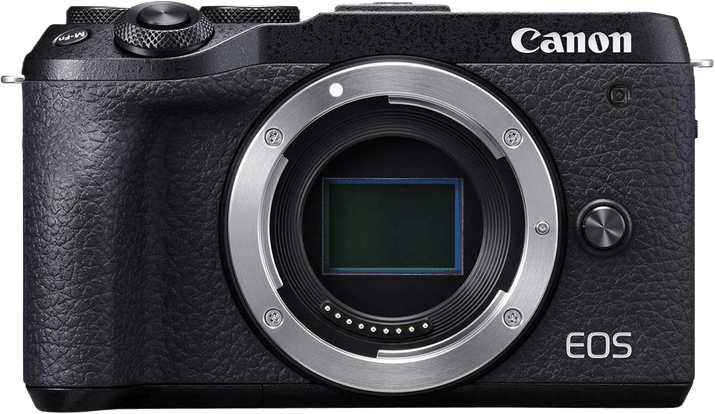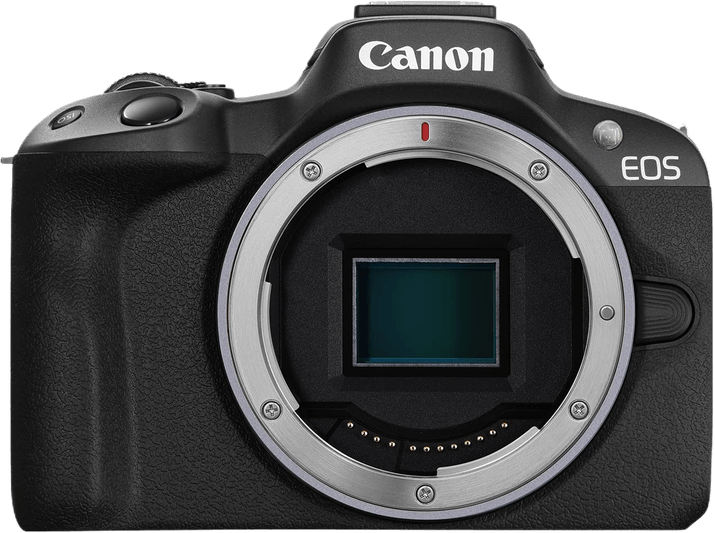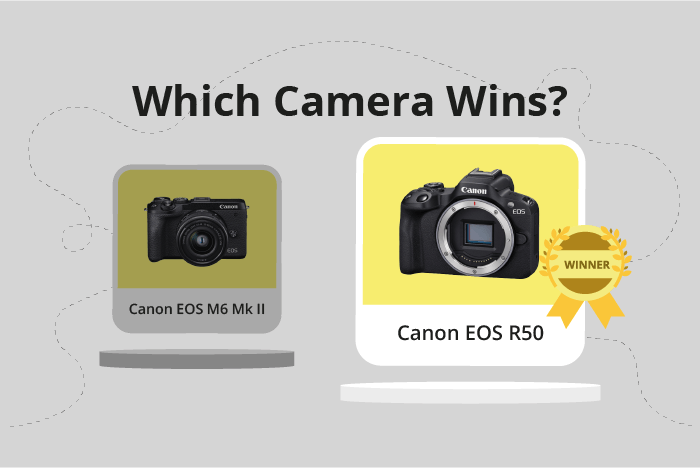Canon EOS M6 Mark II vs EOS R50 Comparison
Canon EOS M6 Mark II

Canon EOS R50

The Canon EOS R50 wins the comparison with a score of 70/100, while the Canon EOS M6 Mark II scores 63/100. Both cameras are mirrorless and share some common specifications.
The winning EOS R50 has a lighter weight of 375g, making it more portable than the M6 Mark II, which weighs 408g. However, the M6 Mark II has a smaller size of 120 x 70 x 49mm, giving it an edge in compactness over the EOS R50’s 116 x 86 x 69mm dimensions.
Considering these points, the Canon EOS R50 provides better value with a higher score and lower price, while the EOS M6 Mark II offers a more compact design.
Canon EOS M6 Mark II vs EOS R50 Overview and Optics
The Canon EOS R50 emerges as the winner in the optics comparison with a score of 73/100, outperforming the Canon EOS M6 Mark II by 11 points, which scored 62/100. Both cameras share some common specifications, such as having a CMOS sensor, an APS-C sensor size, and no image stabilization. However, there are significant differences that contribute to the R50’s victory.
The R50’s Digic X processor gives it an advantage over the M6 Mark II’s Digic 8 processor, allowing for better image processing capabilities. Additionally, the R50 has a higher DXOMARK score for the sensor at 94, compared to the M6 Mark II’s score of 58. This indicates that the R50’s sensor performs better in terms of color depth, dynamic range, and low light performance. Furthermore, the R50 uses the Canon RF lens mount, providing access to a wider range of high-quality lenses compared to the M6 Mark II’s Canon EF-M mount.
On the other hand, the M6 Mark II has a higher megapixel count of 33 and a faster shooting speed of 14 frames per second, compared to the R50’s 24 megapixels and 12 frames per second. This means that the M6 Mark II can capture more detailed images and is better suited for fast action photography.
Taking all these factors into account, the Canon EOS R50’s superior sensor performance, enhanced image processing, and better lens compatibility make it the better camera in terms of optics. However, the Canon EOS M6 Mark II’s higher megapixel count and faster shooting speed may be more appealing to those who prioritize image detail and action photography.
Canon EOS M6 Mark II vs EOS R50 Video Performance
The Canon EOS M6 Mark II and the Canon EOS R50 both score an equal 91/100 in video capabilities, making them strong competitors in this category. Both cameras share common video specifications, such as 4K maximum video resolution, 3840 x 2160 video dimensions, a maximum video frame rate of 120fps, and built-in time-lapse functionality.
The Canon EOS M6 Mark II excels in its compact size and lightweight design, making it a more portable option for videographers on the go. This advantage allows for easier transportation and setup in various shooting environments. The M6 Mark II also offers a lower price point compared to the EOS R50, making it a more budget-friendly choice for those looking to invest in a high-quality camera for video purposes without breaking the bank.
The Canon EOS R50 is still a great contender for video though. Additionally, the R50 is compatible with a wider range of lenses, expanding the creative possibilities for videographers.
In comparing the video capabilities of these two cameras, it becomes clear that both offer exceptional performance. The Canon EOS M6 Mark II is a more portable and budget-friendly option, while the Canon EOS R50 provides great low-light performance and a wider lens compatibility. Ultimately, the choice between these two cameras will depend on the specific needs and priorities of the videographer.
Canon EOS M6 Mark II vs EOS R50 Features and Benefits
The Canon EOS R50 wins the feature comparison with a score of 72/100, while the Canon EOS M6 Mark II scores slightly lower at 70/100. Both cameras share several common features, including a 3-inch touchscreen, flip screen, WIFI, and Bluetooth connectivity. However, neither camera offers GPS functionality.
The Canon EOS R50 outperforms the M6 Mark II in screen resolution, boasting 1,620,000 dots compared to the M6 Mark II’s 1,040,000 dots. This higher resolution provides clearer and sharper image previews, allowing for better composition and focus adjustments.
On the other hand, the Canon EOS M6 Mark II still holds its ground despite the marginally lower feature score. It shares essential features with the R50, such as touchscreen capabilities, flip screen, and wireless connectivity options. Additionally, the two-point difference in the feature score does not significantly impact the overall performance and usability of the M6 Mark II.
In comparing the Canon EOS M6 Mark II and Canon EOS R50, the R50 takes a slight lead due to its superior screen resolution. However, both cameras offer a range of similar features, making them suitable choices for various photography needs. The final decision between these two cameras ultimately depends on the user’s priorities and preferences, as the difference in feature scores is minimal.
Canon EOS M6 Mark II vs EOS R50 Storage and Battery
The Canon EOS M6 Mark II and the Canon EOS R50 both score 35 out of 100 in storage and battery performance. They share some common specifications, such as having one memory card slot, accepting SD/SDHC/SDXC memory cards, using LP-E17 battery type, and offering USB charging.
The Canon EOS R50 takes the lead in battery life, providing 370 shots compared to the 305 shots offered by the Canon EOS M6 Mark II. This longer battery life makes the EOS R50 more suitable for extended shooting sessions. On the other hand, the EOS M6 Mark II has a slight advantage in memory card compatibility, supporting UHS-II cards, while the EOS R50 is compatible with both UHS-I and II cards.
Despite these slight differences, both cameras offer similar storage and battery capabilities, making them equally reliable for most photography needs. Ultimately, the choice between the two cameras will depend on the specific requirements and preferences of the user.
Canon EOS M6 Mark II vs EOS R50 – Our Verdict
Are you still undecided about which camera is right for you? Have a look at these popular comparisons that feature the Canon EOS M6 Mark II or the Canon EOS R50:

